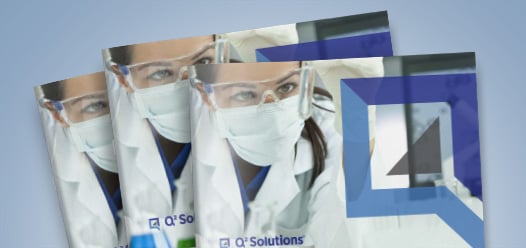Blog
Laboratory Expertise for Early Bactericidal Activity (EBA) Studies
Authors: Dr. Ayaskant Pany and Sorika Van Niekerk
Read somewhere recently: “What is the biggest constraint for tuberculosis (TB) clinical trials? RESOURCES!” This is so true not only in the theoretical sense, but also in practice. From the microbiologic point of view, the TB organism itself is so challenging. Limited funding, manpower, technology, and outreach resources add to the challenge. The scarcity of accredited myco-bacteriological laboratories that are functionally efficient, technically competent, adherent to regulatory and biological safety requirements1 presents a practical constraint. Ideally such a laboratory needs to be within the same geographical location where the trials are conducted, posing a further challenge for many studies.
The theme for World Tuberculosis Day 2018 is “Wanted: Leaders for a TB-free world”. On this day, we acknowledge the work of many before us, while still appreciating the great work ahead, including the need for leadership to address new challenges and create novel solutions.
What are EBA Studies?
Early bactericidal activity (EBA) testing is a reproducible investigation that offers insights into the actions and characteristics of established and newly-developed anti-TB agents.1-3 EBA of an anti-tuberculous agent is estimated by diluting the samples (‘quantifying serial log (10)”) and determining the decline in the colony forming unit (CFU) counts in sputum, usually over the first 14 days of treatment.2 This step is considered as the first in the clinical evaluation of potency of anti-TB drugs/regimens and is used extensively in the TB clinical trial environment.
Patients enrolled in EBA trials are adults who are immunocompetent, treatment-naïve and at low risk of drug resistance or extra pulmonary disease, who can begin standard-of-care treatment for pulmonary TB at the completion of the EBA trial.1
Reproducibility
There are various schools of thoughts regarding the number, timing and amount of sputum that should be collected for this assessment, each with its own obvious advantages and disadvantages. One thing that should be constant is the collection of multiple samples per visit with at least one taken in the early morning at the clinic under supervision. For overnight samples, higher volumes of sputum provide better representation of the quantitative estimation; however, the amount of contaminating bacteria due to the prolonged exposure time with these samples becomes increasingly difficult to control.
The greatest source of variation in EBA results comes from interpatient variation in disease characteristics and sputum sampling,2 but keeping the quality parameters of the laboratory assessment in constant check is also critical. The initial training and competency assessment of the mycobacterial lab staff is a vital step to ensure the conformity, reproducibility, and resulting value of the assay.
Materials and Methods: Specialized approaches for specialized testing
Since the steps of processing the sputum sample in the laboratory are not only tedious but also subjective, any amount of automation will help and has a definite role in EBA testing. Feasibility evaluation and risk assessment suggests that operationalizing robotic pipetting for creation of serially diluted sputum is well achievable. ‘Automated’ plate colony counters (with some manual supervision!) not only aid in decreasing subjectivity, but can also help in raw data capture and filing which are so critical in clinical trial situations using Good Clinical Practice (GCP).
The media which are commonly used in EBA assessments are a cocktail of broad spectrum antibiotics to provide selective growth of the Mycobacteria, on a Middlebrook agar plate. Concentrations are generally trial/study specific. It is hypothesised that incorporation of charcoal in the media counteracts the test drug’s sputum carryover. It is important to note that the charcoal would also adsorb part of the selective antibiotic cocktail, hence increasing the drug doses in the plates having charcoal is advisable.
Scalability
A practical issue which a laboratory should always keep in mind before undertaking an EBA study is its scalability. Clinical trials may be unpredictable in terms of patient randomization, but a unique feature of TB clinical trials, particularly in regions like South Africa, is that patient uptake can ramp up quite quickly once a study starts. Hence, a lab should be ready to scale up to the demand, not only through automation and ensuring they have enough staff, but also through acquisition of large incubator spaces either in the form of walk-in incubators or large ‘white elephant’ incubators. The study may require that thousands of plates be incubated together due to the exponential increase of visits, even with an increase of only a few patients. A lab must be aware that this co-incubation may contribute to increased cross-contamination of the plates.
The risk of cross-contamination and other challenges
Cross contamination can be largely prevented by systematic delineation of work flow with specific areas, benches, and biosafety cabinets for dedicated functions with meticulous surface decontamination and care while performing the assay. Needless to say, staff training, biosafety and quality controls are of paramount importance.
In our experience at Q2 Solutions, we have observed that contamination due to pre-analytical factors can be a concern. Contamination may be particularly high in samples for later visits, perhaps due to clinical factors such as oral microflora alteration, but the exact reason is unclear. Samples from earlier visits (e.g., day -2 through day 7) didn’t show high contamination even though all plates were incubated together. The plate containing charcoal was found to be roughly 5% more contaminated than the plate with the same type but half concentration antibiotic cocktail – both with same sample, same processing methodology, done at the same time and incubated together. Similarly, overnight samples were found to have a higher contamination rate compared with a single supervised sample, with all other parameters being constant.
The overall rate of contamination would usually hover between 5-10%; however, we encountered one episode with contamination reaching 30%. This situation needs very systematic investigation and documentation. The typical contaminants are fungi, sometimes attributed to the failure of Amphotericin B to provide adequate selectivity. The more common contaminants are yeasts, where the Mycobacterium tuberculosis colony counts can still be read, however if moulds are on the plate, it is advisable to discard the plates without opening them. Some data points may be salvageable by delineating and documenting the contaminated plates as ‘contaminated but readable’ or ‘contaminated and not readable’.
Another limitation of EBA studies is its poor correlation with the ability of an agent to prevent relapse (often referred to as sterilizing activity).4 This may be due to inadequate capture of the microbial-host dynamics and necessitates a more comprehensive capture of the treatment effects, aided by molecular, radiologic and immunologic biomarkers. Various studies are evaluating this aspect of EBA studies, so it will be interesting to “watch this space”.4, 5
Finding the best way forward
Due to the technical challenges described above, one wonders whether other subtle surrogate identifiers could provide the kind of information which EBA studies do. The most lucrative of these alternatives is comparison of time to positivity (TTP) via the liquid culture medium. This approach obviously has a lot of promise and has shown good correlation in our experience. Decreased time (at least initially) and increased sensitivity are other advantages with liquid media compared to solid plates; however, this is a semi-quantitative method and the increased sensitivity brings increased risk of contamination which will contribute to increased loss of data points.
Despite the technical challenges, CFU based EBA studies are here to stay at least for the next few years. The satisfaction of successfully completing an EBA study is unparalleled. The TB pipeline promises to deliver a number of new drugs, as well as new regimens and new indications with existing drugs.6,7 As leaders for a TB-free world, we want to see these new technologies and solutions be as successful as possible, particularly when they can offer hope to so many patients and other stakeholders around the globe.
References:
- https://www.fda.gov/downloads/Drugs/GuidanceComplianceRegulatoryInformation/Guidances/UCM373580.pdf
- https://www.ncbi.nlm.nih.gov/pubmed/15482107
- https://clinicaltrials.gov/ct2/show/NCT02371681
- https://www.atsjournals.org/doi/pdf/10.1164/arrd.1980.121.6.939
- https://academic.oup.com/cid/article/39/10/1431/456908
- https://bvgh.org/neglected-disease-product-pipelines/tuberculosis-pipelines-2/
- http://www.aeras.org/
- TB Alliance- NC-005 Study
 Related Blogs:
Related Blogs:
Related Thought Leaders Insights
Visium Spatial Profiling
Visium spatial profiling is a next-generation sequencing method that enables the analysis of cellular relationships by combining transcriptomics with histological techniques. It has advantages over...
Unleashing the power of MHC Associated Peptide Proteomics: Immunogenicity Assessment of Oncology Drugs
By Chloe Ackaert, Jana Schockaert, Aurelie Mazy, Martijn Vlaming, and Sofie PattynPresented at the American Association for Cancer Research (AACR) Annual Meeting, April 5-10, 2024 Bispecifics...
In vitro functional evaluation of immuno-oncology drug candidates in customized bioassays
By Martijn Vlaming, Emmanuelle Sidot, Jezabel Lefèvre, Ellen Boelen, Sofie PattynPresented at AACR (American Association for Cancer Research) Annual Meeting, April 5-10, 2024 Increased...









